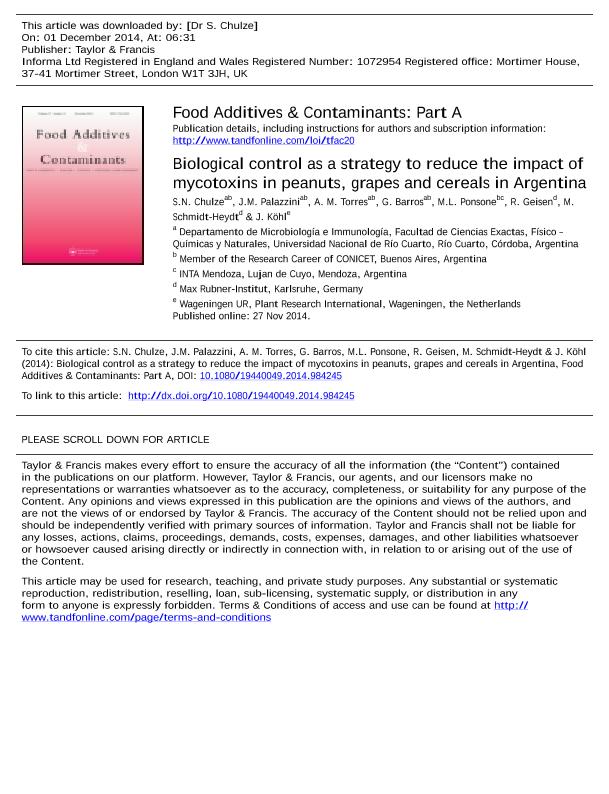Artículo
Biological control as a strategy to reduce the impact of mycotoxins in peanuts, grapes and cereals in Argentina
Chulze, Sofia Noemi ; Palazzini, Juan Manuel
; Palazzini, Juan Manuel ; Torres, Adriana Mabel
; Torres, Adriana Mabel ; Barros, Germán Gustavo
; Barros, Germán Gustavo ; Ponsone, Maria Lorena
; Ponsone, Maria Lorena ; Geisen, R.; Schmidt Heydt, M.; Köhl, J.
; Geisen, R.; Schmidt Heydt, M.; Köhl, J.
 ; Palazzini, Juan Manuel
; Palazzini, Juan Manuel ; Torres, Adriana Mabel
; Torres, Adriana Mabel ; Barros, Germán Gustavo
; Barros, Germán Gustavo ; Ponsone, Maria Lorena
; Ponsone, Maria Lorena ; Geisen, R.; Schmidt Heydt, M.; Köhl, J.
; Geisen, R.; Schmidt Heydt, M.; Köhl, J.
Fecha de publicación:
11/2014
Editorial:
Taylor & Francis
Revista:
Food Additives and Contaminants: Part A
ISSN:
1944-0049
Idioma:
Inglés
Tipo de recurso:
Artículo publicado
Clasificación temática:
Resumen
Mycotoxins including aflatoxins, deoxynivalenol, fumonisins and ochratoxin A are among the main fungal secondary metabolites detected as natural contaminants in South America in different commodities such as peanuts (aflatoxins), cereals (deoxynivalenol and fumonisins) or grapes (ochratoxin A). Different strategies including crop rotation, tillage practices, fungicide application and planting less susceptible cultivars are used in order to reduce the impact of these mycotoxins in both food and feed chains. The development of fungicide resistance in many fungal pathogens as well as rising of public concern on the risks associated with pesticide use led to the search for alternative environmentally friendly methods. Biological control of plant pathogens and toxigenic fungi offers an alternative that can complement chemical control in the frame of an integrated pest management to reduce the impact of mycotoxins in the food and feed chains. The advances made in Argentina on reducing the impact of toxigenic fungi and mycotoxins in peanut, grapes and cereals using the biocontrol strategy are summarised. Native bacteria, yeasts and filamentous fungi have been selected to evaluate them as potential biocontrol agents. Field trials showed that Bacillus subtilis RC 218 and Brevibacillus sp. RC 263 were effective at reducing deoxynivalenol accumulation in wheat. The application of Clonostachys rosea isolates on wheat stubble reduced Fusarium colonisation on the stubble. Bacillus amyloliquefaciens and Microbacterium oleovorans showed good activity to control both Fusarium verticillioides growth and the accumulation of fumonisins at pre-harvest stage in maize. Control of toxigenic Aspergillus flavus and aflatoxin accumulation in peanuts was achieved using a native atoxigenic Aspergillus flavus strain based on competitive exclusion of the toxigenic strains. Kluyveromyces thermotolerans strains were used as biocontrol agents to reduce the impact of Aspergillus section Nigri and ochratoxin A accumulation in grapes.
Palabras clave:
Biocontrol
,
Aspergillus
,
Fusarium
,
Mycotoxin
Archivos asociados
Licencia
Identificadores
Colecciones
Articulos(CCT - CORDOBA)
Articulos de CTRO.CIENTIFICO TECNOL.CONICET - CORDOBA
Articulos de CTRO.CIENTIFICO TECNOL.CONICET - CORDOBA
Articulos(CCT - MENDOZA)
Articulos de CTRO.CIENTIFICO TECNOL.CONICET - MENDOZA
Articulos de CTRO.CIENTIFICO TECNOL.CONICET - MENDOZA
Citación
Köhl, J.; Schmidt Heydt, M.; Geisen, R.; Ponsone, Maria Lorena; Barros, Germán Gustavo; Torres, Adriana Mabel; et al.; Biological control as a strategy to reduce the impact of mycotoxins in peanuts, grapes and cereals in Argentina; Taylor & Francis; Food Additives and Contaminants: Part A; 32; 4; 11-2014; 471-479
Compartir
Altmétricas



